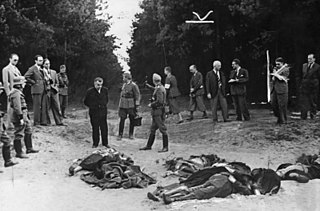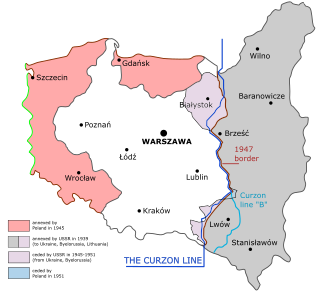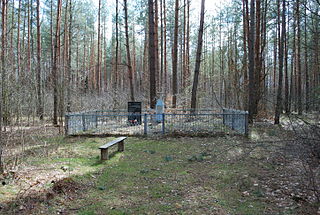 W
WAmnesty for Polish citizens in USSR refers to a one-time amnesty in the USSR for those deprived of their freedom following the Soviet invasion of Poland in World War II. The signing of amnesty by the Presidium of the Supreme Soviet on 12 August 1941, resulted in temporary stop of persecutions of Polish citizens under the Soviet occupation. Their mass persecution accompanied the 1939 annexation of the entire eastern half of the Second Polish Republic in accordance with the Nazi-Soviet Pact against Poland. In order to de-Polonize all newly acquired territories, the Soviet NKVD rounded up and deported between 320,000 and 1 million Polish nationals to the eastern parts of the USSR, the Urals, and Siberia in the atmosphere of terror. There were four waves of deportations of entire families with children, women and elderly aboard freight trains from 1940 until 1941. The second wave of deportations by the Soviet occupational forces across Kresy, affected 300,000 to 330,000 Poles, sent primarily to Kazakh SSR. The amnesty of 1941 was directed specifically at Polish victims of those deportations.
 W
WThe Baligród massacre occurred on Sunday, 6 August 1944 in Baligród, Lesko County, Poland. Ukrainian nationalists with the Ukrainian Insurgent Army (UPA) entered the village of Baligród and killed 42 members of the Polish community.
 W
WBloody Sunday was a sequence of violent events that took place in Bydgoszcz, a Polish city with a sizable German minority, between 3 and 4 September 1939, during the German invasion of Poland.
 W
WByło sobie miasteczko... is a 2009 Polish historical documentary film about the 1943 Kisielin massacre in the village of Kisielin, located in the Wołyń Voivodeship in Poland before World War II,. The film, directed by Tadeusz Arciuch and Maciej Wojciechowski, was produced by Adam Kruk for Telewizja Polska.
 W
WDominopol no longer exists. On July 11, 1943, at the height of the Massacres of Poles in Volhynia, the village was attacked by a death squad of Ukrainian Insurgent Army aided by the Ukrainian peasants, and all ethnic Poles regardless of age and gender were tortured and murdered. Before World War II, Dominopol was a village in the Eastern regions of the Second Polish Republic, located in the Gmina Werba, Powiat Włodzimierz of the Wołyń Voivodeship. The area was invaded by the Soviet Union in 1939 and during Operation Barbarossa annexed by Nazi Germany into Reichskommissariat Ukraine in 1941. The Dominopol location is now in the area of Volodymyr-Volynskyi Raion of the Volyn Oblast in sovereign Ukraine.
 W
WThe ethnic cleansing of Zamojszczyzna by Nazi Germany during World War II was carried out as part of a greater plan of forcible removal of the entire Polish populations from targeted regions of occupied Poland in preparation for the state-sponsored settlement of the ethnic German Volksdeutsche. The operation of mass expulsions from Zamojszczyzna region around the city of Zamość was carried out between November 1942 and March 1943 on direct order from Heinrich Himmler. It was preplanned by both Globocnik from Action Reinhard and Himmler, as the first stage of the eventual murderous ethnic cleansing ahead of projected Germanization of the entire General Government territory.
 W
WGmina Aleksandrów is a rural gmina in Biłgoraj County, Lublin Voivodeship, in eastern Poland. Its seat is the village of Aleksandrów, which lies approximately 16 kilometres (10 mi) south-east of Biłgoraj and 91 km (57 mi) south of the regional capital Lublin.
 W
WThe Huta Pieniacka massacre was a massacre of the Polish inhabitants of the village Huta Pieniacka, located in modern-day Ukraine, which took place on February 28, 1944. Estimates of the number of victims range from 500, to 1,200.
 W
WHuta Stepańska was an ethnic Polish village, located in prewar Kostopol county, Wołyń Voivodeship, in the Second Polish Republic. In 1943, during the Massacres of Poles in Volhynia, it became an important Polish self-defence centre, captured by the UPA between 16 and 18 July 1943. Some 2,000 UIA soldiers, supported by 3,000 local Ukrainian peasants, killed 300 Poles, as they were trying to break out of the encirclement.
 W
WThe Janowa Dolina massacre took place on 23 April 1943 in the village of Janowa Dolina, during the occupation of Poland in World War II. Before the Nazi-Soviet invasion of the Polish Second Republic, Janowa Dolina was a model settlement built in the Kostopol County of the Wołyń Voivodeship by workers of the Polish State Basalt Quarry. The town was inhabited by 2,500 people. Its name, which translates as the "Jan's Valley" in Polish, came from the Polish king Jan Kazimierz, who reportedly hunted in the Volhynian forests, and after hunting — rested on the shore of the Horyń (Horyn) River. The town was destroyed during World War II by Ukrainian nationalists who murdered most of its Polish population including women and children.
 W
WThe Jedwabne pogrom was a massacre of Polish Jews in the town of Jedwabne, German-occupied Poland, on 10 July 1941, during World War II and the early stages of the Holocaust. At least 340 men, women and children were murdered, some 300 of whom were locked in a barn which was then set on fire. About 40 non-Jewish Poles carried out the massacre; German secret service agents met with the ringleaders beforehand, and German military police were present at the crime.
 W
WWoodland cemetery in Jeziorko village in the Northeastern part of Poland is located approximately 7 kilometers (4.3 mi) from the town of Łomża along Route 668. The remains of victims murdered by the Nazi troops rest in the cemetery which is among very few with almost completely documented history of events that happened during the Nazi occupation.
 W
WKuty (Kąty) defence – was a skirmish between Polish self-defense units and Ukrainian Insurgent Army unit under commander Ivan Klymshyn and Andriy Melnyk's supporters in the village of Kuty located in Volhynia, Krzemieniec (Kremenets) county, Shumsk commune 3 or 4 May 1943. During the fight no less than 53 Poles were killed, although the assault was repelled by self-defense forces. After the battle Poles abandoned the village, and escorted by Germans went to Shumsk and later to Kremenets.
 W
WKisielin massacre was a massacre of Polish worshipers which took place in the Volhynian village of Kisielin, now Kysylyn, located in the Volyn Oblast, Ukraine. It took place on Sunday, July 11, 1943, when units of the Ukrainian Insurgent Army (UPA), supported by local Ukrainian peasants, surrounded Poles who had gathered for a ceremony at a local Roman-Catholic church. Around 60 to 90 persons or more, men, women and children – were ordered to take off their clothes and were then massacred by machine gun. The wounded were killed with weapons such as axes and knives. Those who survived escaped to the presbytery and barricaded themselves for eleven hours.
 W
WThe Korosciatyn massacre took place on the night of February 28/29, 1944, during the province-wide wave of massacres of Poles in Volhynia in World War II. Korosciatyn, which now bears the name of Krynica and is located in western Ukraine, was one of the biggest ethnic Polish villages of the interwar Poland’s within Buczacz County in Tarnopol Voivodeship (pictured). Located along the railway line from Tarnopol to Stanislawów, in 1939 it had some 900 inhabitants, all of them being ethnic Poles. Korosciatyn had an elementary school, a Roman Catholic church and a railway station. It belonged to the Latin Rite Roman Catholic parish of nearby Monasterzyska, which also covered several nearby villages. Among the most famous of the citizens of this parish, are Rev. Stanislaw Padewski, professor Gabriel Turowski as well as two scientists, professor Michal Lesiow of Lublin’s Maria Curie University and doctor Jan Zaleski of Krakow’s Pedagogical College. Altogether, in 1939 the Deaconry of Buczacz had around 45 000 Polish inhabitants.
 W
WEastern Borderlands or simply Borderlands was a term coined for the eastern part of the Second Polish Republic during the interwar period (1918–1939). Largely agricultural and extensively multi-ethnic, it amounted to nearly half of the territory of pre-war Poland. Historically situated in the eastern Polish–Lithuanian Commonwealth, following the 18th-century foreign partitions it was annexed by Russia and partly by the Habsburg Monarchy (Galicia), and ceded back to Poland in 1921 after the Peace of Riga. As a result of the post-World War II border changes, none of the lands remain in Poland today.
 W
WIn July 1941, 25 Polish academics from the city of Lwów along with their families were killed by Nazi German occupation forces. By targeting prominent citizens and intellectuals for elimination, the Nazis hoped to prevent anti-Nazi activity and to weaken the resolve of the Polish resistance movement. According to an eyewitness the executions were carried out by an Einsatzgruppe unit under the command of Karl Eberhard Schöngarth with the participation of Ukrainian translators in German uniforms.
 W
WThe massacres of Poles in Volhynia and Eastern Galicia, were carried out in German-occupied Poland by the Ukrainian Insurgent Army, or the UPA, with the support of parts of the local Ukrainian population against the Polish minority in Volhynia, Eastern Galicia, parts of Polesia and Lublin region from 1943 to 1945. The peak of the massacres took place in July and August 1943. Most of the victims were women and children. Many of the Polish victims regardless of age or gender were tortured before being killed; some of the methods included rape, dismemberment or immolation, among others. The UPA's actions resulted in between 50,000 and 100,000 deaths.
 W
WMassacre of Ostrówki refers to the mass murder of the Polish inhabitants of the Volhynian village of Ostrówki, located during the interbellum in the gmina Hushcha, Liuboml, Volhynian Voivodeship of the Second Polish Republic, now known as Ostrowky, located in the Manevychi Raion of Volyn, Ukraine. On 30 August 1943, armed members of the Ukrainian Insurgent Army (UIA) murdered 438 Poles. Among the victims were 246 children under the age of 14.
 W
WThe Palikrowy massacre was a war crime committed by 4th police SS-regiment made up of Ukrainian soldiers of the SS-Galizien who were removed from the SS-Galizien at the time of the massacre and placed under German police command, Ukrainian SVK forces and Ukrainian Insurgent Army on Poles in the village of Palikrowy, which took place on 12 March 1944. A total of 385 Poles were killed.
 W
WThe Parośla I massacre was committed during World War II by the Ukrainian Insurgent Army (UPA) under the command of Hryhorij Perehijniak "Dowbeszka-Korobka" on 9 February 1943 against the ethnic Polish residents of the village of Parośla in the Nazi-controlled Reichskommissariat Ukraine. It is considered a prelude to the ethnic cleansing of Poles in the Volhynia region by the UPA, and is recognized as the first mass murder committed by the Ukrainian Insurgent Army in the area. Estimates of the number of victims range from 149 to 173.
 W
WThe Pidkamin massacre or the Podkamień massacre of 12 March 1944 was the massacre of Polish civilians committed by the Ukrainian Insurgent Army (UPA) under the command of Maksym Skorupsky (Maks), in cooperation with a unit of the 14th SS-Volunteer Division "Galician". The victims were ethnic Polish residents of the Eastern Galician village of Podkamień in the occupied Second Polish Republic's Tarnopol Voivodeship. During the war the area was administratively part of the Nazi German Reichskommissariat Ukraine. Estimates of victims include 150, more than 250 and up to 1000.
 W
WThe Ponary massacre or Paneriai massacre was the mass murder of up to 100,000 people, mostly Jews, Poles, and Russians, by German SD and SS and their Lithuanian collaborators, including Ypatingasis būrys killing squads, during World War II and the Holocaust in Reichskommissariat Ostland. The murders took place between July 1941 and August 1944 near the railway station at Ponary, a suburb of today's Vilnius, Lithuania. Some 70,000 Jews were murdered at Ponary, along with up to 20,000 Poles, and 8,000 Russian POWs, most of them from nearby Vilna (Vilnius), and its newly-formed Vilna Ghetto.
 W
WThe Przebraże Defence – defensive fights in the village of Przebraże belonging to the Trościaniec cluster, in Lutsk poviat, voivodeship in Volhynia between July 1943 and January 1944. In Przebraże, Polish civilians from Volhynia organized defense against the UPA. The village was never conquered by UPAs.
 W
WA sybirak is a person resettled to Siberia. Like its Russian counterpart sibiryák the word can refer to any dweller of Siberia, but it more specifically refers to Poles imprisoned or exiled to Siberia or even to those sent to the Russian Arctic or to Kazakhstan in the 1940s.
 W
WSzczuczyn pogrom was the massacre of some 300 Jews in the community of Szczuczyn carried out by its Polish inhabitants in June 1941 after the town was bypassed by the invading German soldiers in the beginning of Operation Barbarossa. The June massacre was stopped by German soldiers.
 W
WMassacre of Wola Ostrowiecka was a 1943 mass murder of Polish inhabitants of the village of Wola Ostrowiecka located in the prewar gmina Huszcza in Luboml County of the Volhynian Voivodeship, within the Second Polish Republic. Wola Ostrowiecka no longer exists. It was burned to the ground during the Massacres of Poles in Volhynia and Eastern Galicia.
 W
WAround six million Polish citizens, are estimated to have perished during World War II. Most were civilians killed by the actions of Nazi Germany and the Soviet Union. At the International Military Tribunal held in Nuremberg, Germany, in 1945–46, three categories of wartime criminality were juridically established: waging a war of aggression; war crimes; and crimes against humanity. These three crimes in international law were for the first time, from the end of the war, categorized as violations of fundamental human values and norms. These crimes were committed in occupied Poland on a tremendous scale.
 W
W